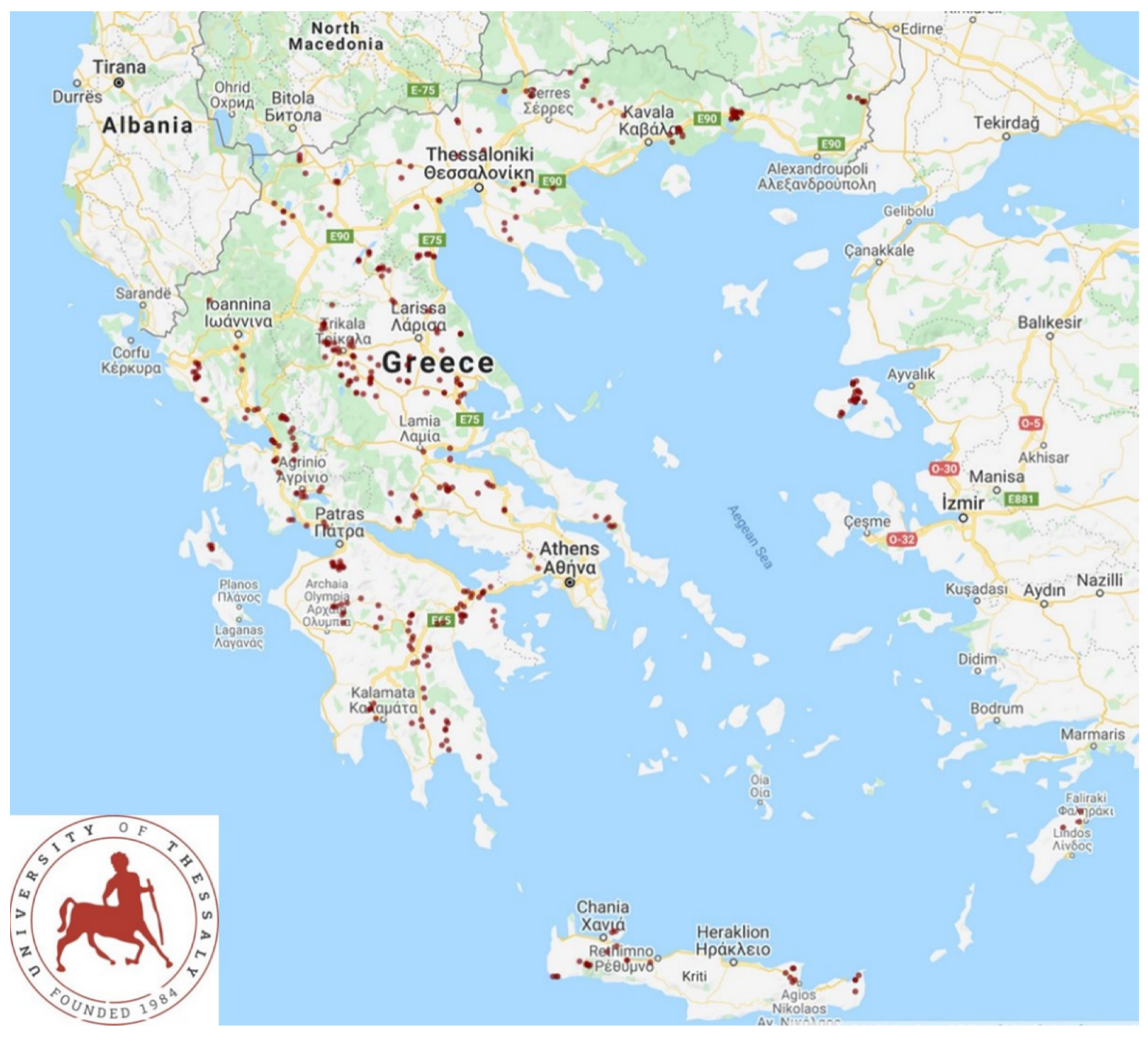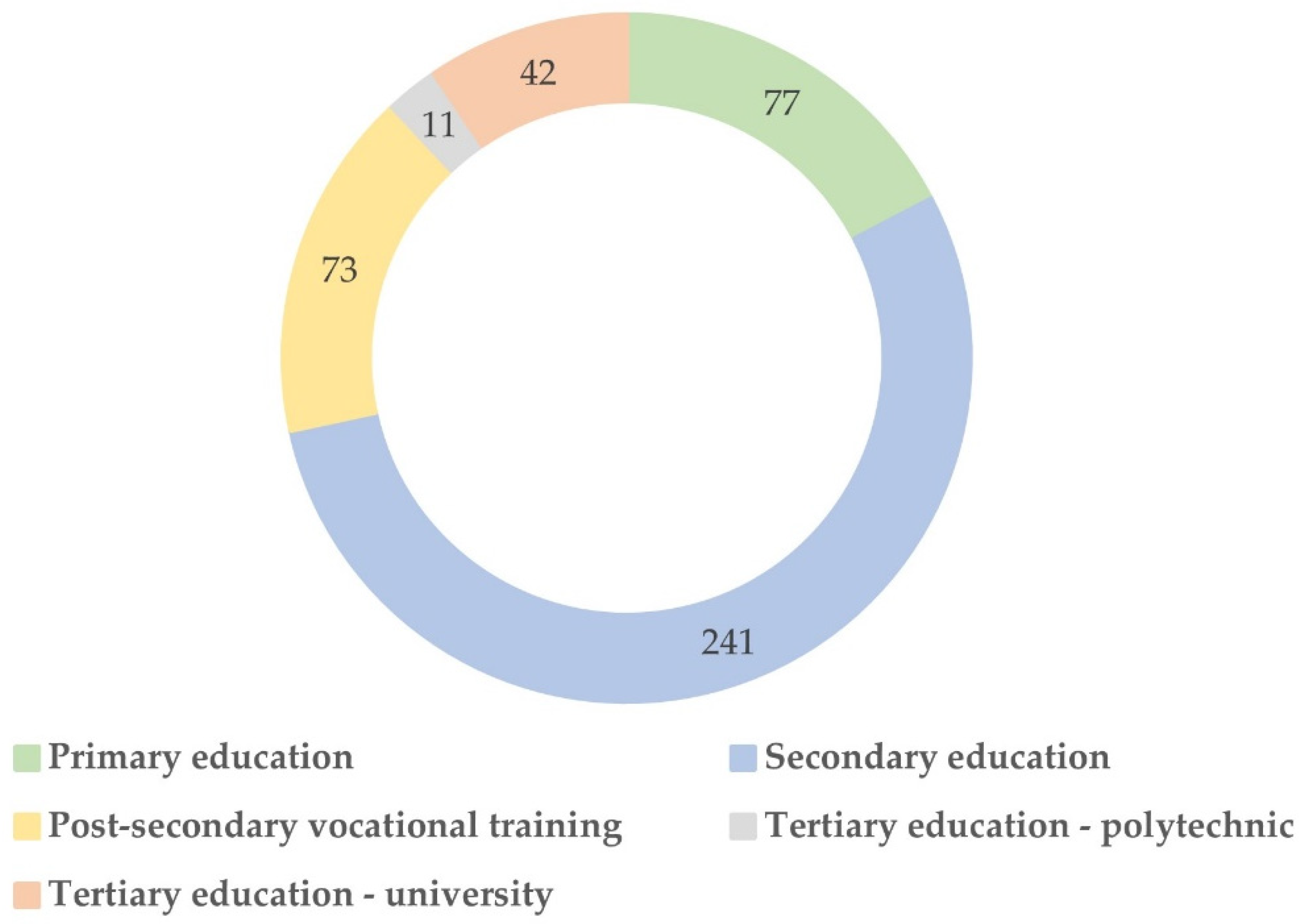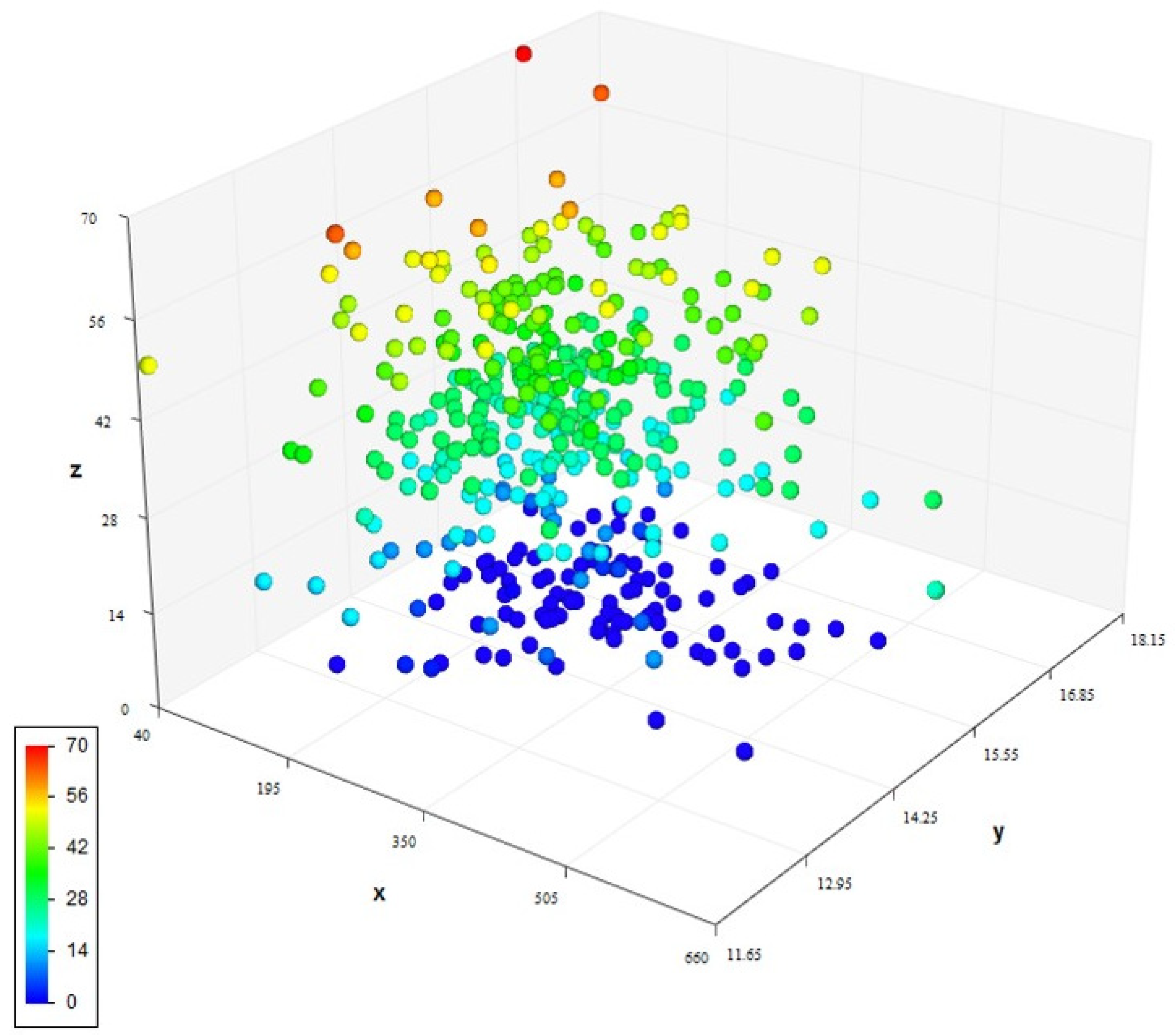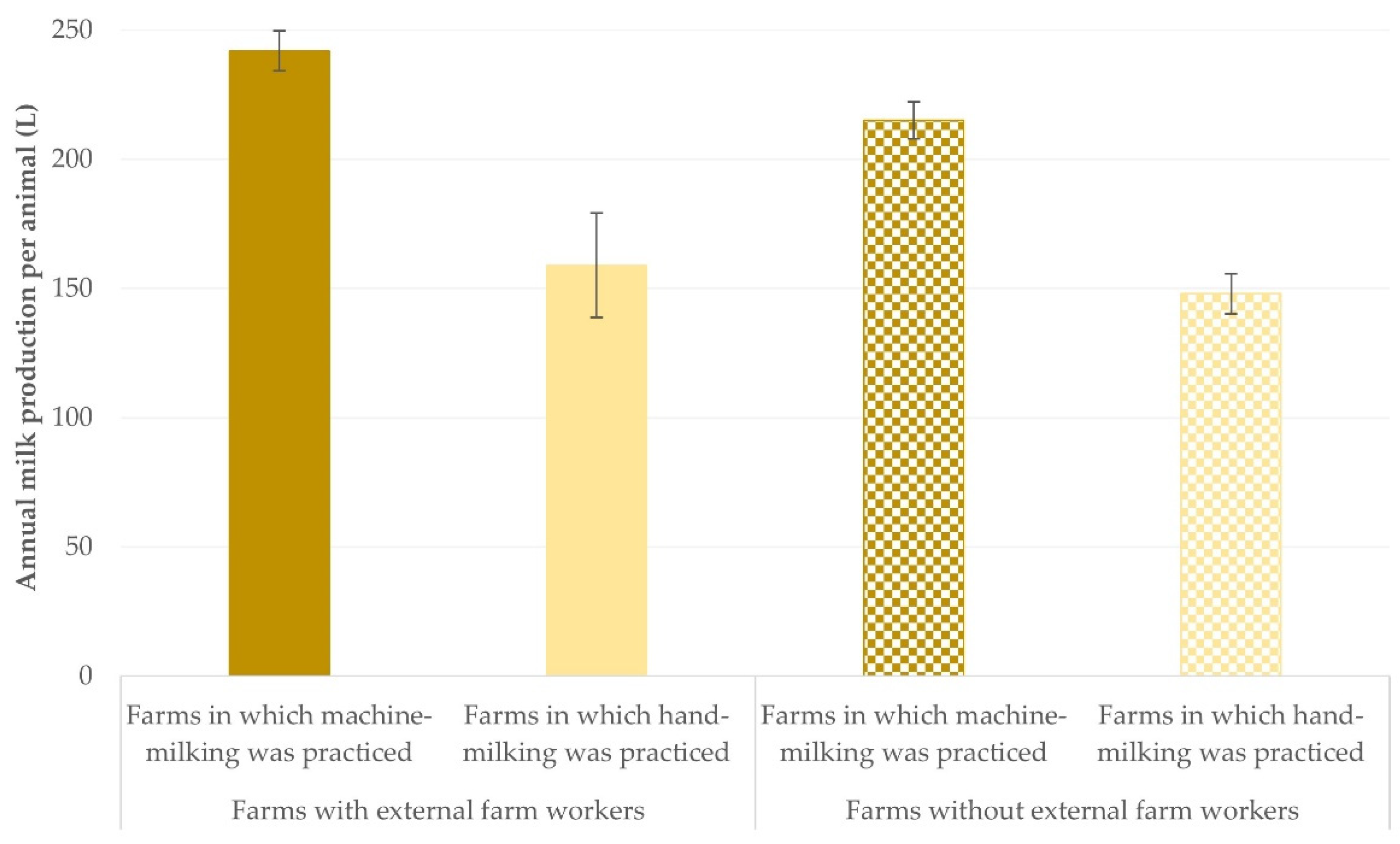Dairy Sheep and Goat Farmers: Socio-Demographic Characteristics and Their Associations with Health Management and Performance on Farms
Abstract
:1. Introduction
2. Materials and Methods
2.1. Small Ruminant Farms
2.2. Interviews of Farmers
2.3. Sample Collection
2.4. Body Condition Scoring of Animals
2.5. Laboratory Examinations
2.6. Data Management and Analysis
2.6.1. Characteristics of Farmers That Were Studied
2.6.2. Statistical Analysis
3. Results
3.1. Description of the Characteristics of Farmers
3.1.1. Gender and Age of Farmers
3.1.2. Farming Experience and Farming Work by Farmers
3.1.3. Highest Level of Education Received by Farmers
3.1.4. Main Language Spoken by Farmers
3.1.5. Family
3.2. External Farm Workers
3.3. Associations with Management Practices, Production Outcomes or Health Parameters on the Farms
3.3.1. Importance of Farming Experience by Farmers
3.3.2. Importance of External Farm Workers
4. Discussion
4.1. Preamble
4.2. Socio-Demographic Characteristics of Farmers
4.3. Association with Management-, Production- and Health-Related Variables
5. Conclusions
Supplementary Materials
Author Contributions
Funding
Institutional Review Board Statement
Informed Consent Statement
Data Availability Statement
Acknowledgments
Conflicts of Interest
Appendix A
| Part of the country (central part, islands, north part, south part) |
| Animal species farmed |
| Management system applied in the farm (description according to EFSA classification) [8] |
| Machine- or hand-milking |
| Number of animals in the farm (no.) |
| Breed of animals (description) |
| Application of quarantine measures for animals newly entering into a farm (yes/no) |
| Occasions in which cleaning and disinfections procedures are performed at the farms annually (no.) |
| Laboratory evaluation of feedstuffs and water provided to the animals (yes/no) |
| Use of ultrasonographic examination for pregnancy diagnosis (yes/no) |
| Vaccination against clostridial infections (yes/no) |
| Administration of ‘dry-ewe’ treatment at the end of the lactation period (yes/no) |
| Method of calculation of bodyweight for administration of drugs to animals (estimation/weighing) |
| Keeping prescribed withdrawal periods after drug administration (yes/no) |
| Provision of care to the newborns (yes/no) |
| Maintenance of a colostrum bank in the farm (yes/no) |
| Number of veterinary visits to farm annually (no.) |
| Mean milk production per ewe or doe during the preceding season (litres) |
| Fat content of the bulk-tank milk (%) |
| Protein content of the bulk-tank milk (%) |
| Mean number of lambs or kids born per ewe or doe during the preceding season (no.) |
| Body condition score (1–5) |
| Incidence risk of clinical mastitis during the preceding season (%) |
| Somatic cell counts in the bulk-tank milk (cells mL−1) |
| Total bacterial counts in the bulk-tank milk (cfu mL−1) |
| Incidence risk of deaths of deaths of adult animals during the preceding season (%) |
References
- Hellenic Agricultural Organisation—Demeter. Deliveries of Ovine and Caprine Milk by Region and Regional Authority and Average Milk Price—Calendar Year 2019. Cumulative Data Updated. Available online: https://www.elgo.gr/images/ELOGAK_files/Statistics/2020/AIGO_%CE%A0%CE%B1%CF%81%CE%B1%CE%B4%CF%8C%CF%83%CE%B5%CE%B9%CF%82_%CE%A0%CF%81%CF%8C%CE%B2%CE%B5%CE%B9%CE%BF%CF%85_%CE%BA%CE%B1%CE%B9_%CE%93%CE%AF%CE%B4%CE%B9%CE%BD%CE%BF%CF%85_%CE%93%CE%AC%CE%BB%CE%B1%CE%BA%CF%84%CE%BF%CF%82_2019.pdf (accessed on 20 December 2020).
- Pulina, G.; Milan, M.J.; Lavin, M.P.; Theodoridis, A.; Morin, E.; Capote, J.; Thomas, D.L.; Francesconi, A.H.D.; Caja, G. Current production trends, farm structures, and economics of the dairy sheep and goat sector. J. Dairy Sci. 2018, 101, 6715–6729. [Google Scholar] [CrossRef] [PubMed] [Green Version]
- Corner-Thomas, R.A.; Kenyon, S.P.R.; Morris, T.; Ridler, A.I.; Hickson, R.E.; Greer, A.W.; Logan, C.M.; Blair, H.T. Influence of demographic factors on the use of farm management tools by New Zealand farmers. N. Z. J. Agric. Res. 2015, 58, 412–422. [Google Scholar] [CrossRef]
- European Commission. Common Agricultural Policy: Young farmers. Available online: https://ec.europa.eu/info/food-farming-fisheries/key-policies/common-agricultural-policy/income-support/young-farmers_en (accessed on 20 July 2021).
- DePeters, E.J.; Cant, J.P. Nutritional factors influencing the nitrogen composition of bovine milk: A review. J. Dairy Sci. 1992, 75, 2043–2070. [Google Scholar] [CrossRef]
- Bencini, R.; Pulina, B. The quality of sheep milk: A review. Aus. J. Exp. Agric. 1997, 37, 485–504. [Google Scholar] [CrossRef]
- Paape, M.J.; Wiggans, G.R.; Bannerman, D.D.; Thomas, D.L.; Sanders, A.H.; Contreras, A.; Moroni, P.; Miller, R.H. Monitoring goat and sheep milk somatic cell counts. Small Rumin. Res. 2007, 68, 114–125. [Google Scholar] [CrossRef]
- Sargison, N. Sheep Flock Health a Planned Health Approach; Blackwell Science: Oxford, UK, 2008; p. 465. [Google Scholar]
- Adjou, K.; Autef, P. Practical Guide of Ovine Medicine and Surgery; Wolters-Kluwer France: Ruell-Malmaison, France, 2013; p. 192. [Google Scholar]
- Lianou, D.T.; Chatziprodromidou, I.P.; Vasileiou, N.G.C.; Michael, C.K.; Mavrogianni, V.S.; Politis, A.P.; Kordalis, N.G.; Billinis, C.; Giannakopoulos, A.; Papadopoulos, E.; et al. A detailed questionnaire for the evaluation of health management in dairy sheep and goats. Animals 2020, 10, 1489. [Google Scholar] [CrossRef] [PubMed]
- Martin, W.B.; Aitken, A.I. Appendix C. In Diseases of Sheep, 3rd ed.; Martin, W.B., Aitken, I.A., Eds.; Blackwell Science: Oxford, UK, 2000; p. 502. [Google Scholar]
- Laird, D.T.; Gambrel-Lenarz, S.A.; Scher, F.M.; Graham, T.E.; Reddy, R. Microbiological Count Methods. In Standard Methods for the Examination of Dairy Products, 17th ed.; Wehr, H.M., Frank, J.F., Eds.; APHA Press: Washington, DC, USA, 2004; pp. 153–186. [Google Scholar]
- European Food Safety Authority. Scientific opinion on the welfare risks related to the farming of sheep for wool, meat and milk production. EFSA J. 2014, 12, 3933–4060. [Google Scholar]
- Wiggans, G.R.; Shook, G.E. A lactation measure of somatic cell count. J. Dairy Sci. 1987, 70, 2666–2672. [Google Scholar] [CrossRef]
- Franzoi, M.; Manuelian, C.L.; Penasa, M.; De Marchi, M. Effects of somatic cell score on milk yield and mid-infrared predicted composition and technological traits of Brown Swiss, Holstein Friesian, and Simmental cattle breeds. J. Dairy Sci. 2020, 103, 791–804. [Google Scholar] [CrossRef] [PubMed]
- Hadjigeorgiou, I.; Vallerand, F.; Tsimpoukas, K.; Zervas, G. The socio-economics of sheep and goat farming in Greece and the implications for future rural development. Opt. Méditerran. B Etud. Recherch. 2002, 39, 83–93. [Google Scholar]
- Thanopoulos, G. Agricultural and Shepherding Life. In Public and Private Life in Greece II: The Recent Years; Ekaterinidis, G., Alexakis, E., Giatrakou, M.E., Thanopoulos, G., Spathari-Begliti, E., Tzakis, D., Eds.; Greek Open University: Patras, Greece, 2002; pp. 80–87. [Google Scholar]
- Arseniou, L.A. The Tseliggata, 2nd ed.; Private Edition: Larissa, Greece, 1972; p. 68. [Google Scholar]
- Ministry of Agricultural Development & Food. Greek Agriculture—Animal Production; Ministry of Agricultural Development & Food, General Directorate for Animal Production: Athens, Greece, 2018; p. 16.
- Hellenic Statistical Authority. Greece in Numbers; Hellenic Statistical Authority: Athens, Greece, 2021; p. 83. [Google Scholar]
- Fthenakis, G.C.; Arsenos, G.; Brozos, C.; Fragkou, I.A.; Giadinis, N.D.; Giannenas, I.; Mavrogianni, V.S.; Papadopoulos, E.; Valasi, I. Health management of ewes during pregnancy. Anim. Reprod. Sci. 2012, 130, 198–212. [Google Scholar] [CrossRef] [PubMed]
- Kasimis, C.; Papadopoulos, A.G.; Zacopoulou, E. Migrants in rural Greece. Sociol. Rural. 2003, 43, 167–184. [Google Scholar] [CrossRef]
- Anthopoulou, A.; Kaberis, N.; Petrou, M. Aspects and experiences of crisis in rural Greece. Narratives of rural resilience. J. Rural Stud. 2017, 52, 1–11. [Google Scholar] [CrossRef]
- Tsiaousi, A.; Partalidou, M. Female farmers in Greece: Looking beyond the statistics and into cultural-social characteristics. Outl. Agric. 2020, 50, 55–63. [Google Scholar] [CrossRef]
- Kasimis, C.; Papadopoulos, A.G. Rural Transformations and Family Farming in Contemporary Greece. In Research in Rural Sociology and Development; Marsden, T., Ed.; Emerald Publishing: Bingley, UK, 2013; pp. 263–293. [Google Scholar]
- Halfacree, K.H. Rurality and post-rurality. Int. Encycl. Hum. Geogr. 2009, 9, 449–456. [Google Scholar]
- Anastasiou, E.; Duquenne, M.N. Return to the Rural in Greece During the Last Decade: A Methodological Approach of the Potential Spatial Patterns. In Proceedings of the 5th International Conference of the Balkans Demography: The Population of the Balkans at the Dawn of the 21st Century, Ohrid, North Macedonia, 21–24 October 2017; pp. 331–354. [Google Scholar]
- Anastasiou, E.; Duquenne, M.N. Determinants and spatial patterns of counterurbanisation in times of crisis: Evidence from Greece. Popul. Rev. 2020, 59, 85–110. [Google Scholar]
- Kasimis, C.; Papadopoulos, A.G. The de-agriculturalisation of the Greek countryside: The changing characteristics of an ongoing socio-economic transformation. In Europe’s Green Ring; Granberg, L., Kovacs, I., Tovey, H., Eds.; Routledge: Aldershot, UK, 2001; pp. 179–218. [Google Scholar]
- Lazaridis, G.; Psimmenos, I. Migrant flows from Albania to Greece: Economic, social, and spatial exclusion. In Eldorado or Fortress? Migration in Southern Europe; King, R., Lazaridis, G., Tsardanidis, C., Eds.; Macmillan: London, UK, 2000; pp. 170–185. [Google Scholar]
- Papadopoulos, A.G. Rural immigrations and female employment. In Rural Gender Relations: Issues and Case Studies; Bock, B.B., Shortall, S., Eds.; CABI: London, UK, 2006; pp. 196–213. [Google Scholar]
- Lianos, T.P.; Sarris, A.H.; Katseli, L. Illegal migration and local labour markets: The case of Northern Greece. Int. Migr. 1996, 34, 449–484. [Google Scholar] [CrossRef] [PubMed]
- Liu, J.; Toma, L.; Barnes, A.P.; Stott, A. Farmers’ uptake of animal health and welfare technological innovations. Implications for animal health policies. Fr. Vet. Sci. 2019, 6, 410. [Google Scholar] [CrossRef] [PubMed] [Green Version]
- Tauer, L. Age and farmer productivity. Rev. Agric. Econ. 1995, 17, 63–69. [Google Scholar] [CrossRef]




| Variables Related to Management Practices, Production Outcomes or Health Parameters b | Socio-Demographic Characteristics of Farmers | |||||||||
|---|---|---|---|---|---|---|---|---|---|---|
| Gender | Age | Farming Experience | Farming Work | Daily Period at the Farm | Highest Level of Education Received | Farming-Family Tradition | Family Members | Family Member at the Farm | Employment of Farm Workers | |
| Location of farm (area of the country) | <0.001 | 0.002 | ||||||||
| Animal species farmed | ||||||||||
| Management system followed in farm | <0.001 | 0.026 | <0.001 | |||||||
| Application of machine- or hand-milking | 0.046 | 0.013 | 0.010 | <0.001 | ||||||
| No. of animals in farm | 0.009 | 0.037 | 0.027 | <0.001 | ||||||
| Animal breed | 0.033 | 0.002 | ||||||||
| Application of quarantine for new animals into a farm | 0.013 | <0.001 | ||||||||
| Annual occasions of cleaning and disinfection | 0.004 | |||||||||
| Laboratory evaluation of feedstuffs and water | 0.004 | <0.001 | ||||||||
| Ultrasonographic examination for pregnancy diagnosis | 0.024 | <0.001 | 0.008 | |||||||
| Vaccination against clostridial infections | <0.001 | 0.042 | <0.001 | |||||||
| Administration of ‘dry-ewe’ treatment | <0.001 | 0.001 | ||||||||
| Method of calculation of bodyweight | <0.001 | 0.016 | 0.008 | |||||||
| Maintenance of withdrawal periods after drug administration | ||||||||||
| Care to the newborns | 0.027 | |||||||||
| Maintenance of colostrum bank | 0.009 | |||||||||
| Annual veterinary visits | 0.021 | 0.037 | 0.006 | |||||||
| Annual milk production per animal | 0.002 | <0.001 | ||||||||
| Fat content in bulk-tank milk | 0.018 | |||||||||
| Protein content in bulk-tank milk | 0.027 | |||||||||
| Newborns per animal | 0.025 | <0.001 | 0.024 | |||||||
| Body condition score | <0.001 | |||||||||
| Annual incidence risk of clinical mastitis | ||||||||||
| Bulk-tank milk somatic cell counts | 0.027 | 0.002 | 0.003 | |||||||
| Bulk-tank milk total bacterial counts | 0.008 | 0.12 | ||||||||
| Annual incidence risk of deaths of adult animals | 0.018 | |||||||||
| Variables | p | |||
|---|---|---|---|---|
| Farmers in Central Greece (n = 169) | Farmers in the Islands of Greece (n = 59) | Farmers in Northern Greece (n = 123) | Farmers in Southern Greece (n = 93) | |
| 20.0 ± 1.2 years | 33.5 ± 2.2 years | 24.9 ± 1.4 years | 25.5 ± 1.5 years | <0.001 |
| Farmers following intensive management system (n = 53) | Farmers following semi-intensive management system (n = 169) | Farmers following semi-extensive management system (n = 177) | Farmers following extensive management system (n = 45) | |
| 15.3 ± 2.2 years | 22.3 ± 1.1 years | 26.1 ± 1.2 years | 35.6 ± 2.2 years | <0.001 |
| Farmers with imported animal breeds (n = 184) | Farmers with indigenous animal breeds (n = 260) | |||
| 20.2 ± 1.1 years | 27.2 ± 1.0 years | <0.001 | ||
| Farmers applying quarantine measures (n = 374) | Farmers not applying quarantine measures (n = 70) | |||
| 23.3 ± 0.8 years | 29.7 ± 2.0 years | 0.002 | ||
| Farmers performing laboratory evaluation of feedstuffs and water provided to animals (n = 134) | Farmers not performing laboratory evaluation of feedstuffs and water provided to animals (n = 310) | |||
| 23.0 ± 1.4 years | 26.0 ± 0.9 years | 0.002 | ||
| Farmers using ultrasonographic examination for pregnancy diagnosis in the farm (n = 139) | Farmers not using ultrasonographic examination for pregnancy diagnosis in the farm (n = 305) | |||
| 17.9 ± 1.3 years | 27.6 ± 0.9 years | <0.001 | ||
| Farmers performing anti-clostridial vaccination to the animals (n = 434) | Farmers not performing anti-clostridial vaccination to the animals (n = 10) | |||
| 24.0 ± 0.8 years | 37.5 ± 6.1 years | 0.009 | ||
| Farmers estimating bodyweight of animals before drug administration (n = 344) | Farmers weighing animals before drug administration (n = 100) | |||
| 22.6 ± 0.8 years | 30.3 ± 1.8 years | <0.001 | ||
| Farmers maintaining a colostrum bank in the farm (n = 58) | Farmers not maintaining a colostrum bank in the farm (n = 386) | |||
| 18.5 ± 2.0 years | 25.2 ± 0.8 years | 0.003 | ||
| Annual veterinary visits | ||||
| r = −0.1268 | 0.004 | |||
| Annual milk production per animal | ||||
| r = −0.1725 | <0.001 | |||
| Newborns per animal | ||||
| r = −0.1291 | 0.003 | |||
| Somatic cell counts | ||||
| r = 0.0511 | 0.14 | |||
| Total bacterial counts | ||||
| r = 0.0887 | 0.031 | |||
| Ext. Farm Worker Employ. a | No Ext. Farm Worker Employ. a | Ext. Farm Worker Employ. a | No Ext. Farm Worker Employ. | Ext. Farm Worker Employ. | No Ext. Farm Worker Employ. | Ext. Farm Worker Employ. | No Ext. Farm Worker Employ. | p |
|---|---|---|---|---|---|---|---|---|
| Farmers following intensive management system (n = 53) | Farmers following semi-intensive management system (n = 169) | Farmers following semi-extensive management system (n = 177) | Farmers following extensive management system (n = 45) | |||||
| (75.5%) | (24.5%) | (40.2%) | (59.8%) | (24.3% | (75.7%) | (13.3%) | (86.7%) | <0.001 |
| Ext. Farm Worker Employ. | No Ext. Farm Worker Employ. | Ext. Farm Worker Employ. | No Ext. Farm Worker Employ. | p | ||||
| Farmers applying machine-milking (n = 321) | Farmers applying hand-milking (n = 119) | |||||||
| 44.2% | 55.8% | 12.2% | 87.8% | <0.001 | ||||
| Farmers with imported animal breeds (n = 184) | Farmers with indigenous animal breeds (n = 260) | |||||||
| 44.6% | 55.4% | 28.8% | 71.2% | <0.001 | ||||
| Farmers applying quarantine measures (n = 374) | Farmers not applying quarantine measures (n = 70) | |||||||
| 39.3% | 60.7% | 14.3% | 85.7% | <0.001 | ||||
| Farmers performing laboratory evaluation of feedstuffs and water provided to animals (n = 134) | Farmers not performing laboratory evaluation of feedstuffs and water provided to animals (n = 310) | |||||||
| 50.8% | 49.2% | 42.4% | 57.6% | <0.001 | ||||
| Farmers using ultrasonographic examination for pregnancy diagnosis in the farm (n = 139) | Farmers not using ultrasonographic examination for pregnancy diagnosis in the farm (n = 305) | |||||||
| 47.5% | 52.5% | 29.8% | 70.2% | <0.001 | ||||
| External Farm Worker Employment | No External Farm Worker Employment | p | ||||||
| Number of animals | ||||||||
| 414.5 ± 22.4 animals | 239.4 ± 10.8 animals | <0.001 | ||||||
| Annual veterinary visits | ||||||||
| 8.6 ± 0.6 visits | 6.6 ± 0.4 visits | 0.003 | ||||||
| Annual milk production per animal | ||||||||
| 234.4 ± 7.5 L | 189.9 ± 5.7 L | <0.001 | ||||||
| Protein content in bulk-tank milk | ||||||||
| 4.2% ± 0.04% | 4.1% ± 0.04% | 0.021 | ||||||
| Newborns per animal | ||||||||
| 1.4 ± 0.02 newborns | 1.3 ± 0.01 newborns | 0.005 | ||||||
Publisher’s Note: MDPI stays neutral with regard to jurisdictional claims in published maps and institutional affiliations. |
© 2021 by the authors. Licensee MDPI, Basel, Switzerland. This article is an open access article distributed under the terms and conditions of the Creative Commons Attribution (CC BY) license (https://creativecommons.org/licenses/by/4.0/).
Share and Cite
Lianou, D.T.; Fthenakis, G.C. Dairy Sheep and Goat Farmers: Socio-Demographic Characteristics and Their Associations with Health Management and Performance on Farms. Land 2021, 10, 1358. https://doi.org/10.3390/land10121358
Lianou DT, Fthenakis GC. Dairy Sheep and Goat Farmers: Socio-Demographic Characteristics and Their Associations with Health Management and Performance on Farms. Land. 2021; 10(12):1358. https://doi.org/10.3390/land10121358
Chicago/Turabian StyleLianou, Daphne T., and George C. Fthenakis. 2021. "Dairy Sheep and Goat Farmers: Socio-Demographic Characteristics and Their Associations with Health Management and Performance on Farms" Land 10, no. 12: 1358. https://doi.org/10.3390/land10121358
APA StyleLianou, D. T., & Fthenakis, G. C. (2021). Dairy Sheep and Goat Farmers: Socio-Demographic Characteristics and Their Associations with Health Management and Performance on Farms. Land, 10(12), 1358. https://doi.org/10.3390/land10121358






